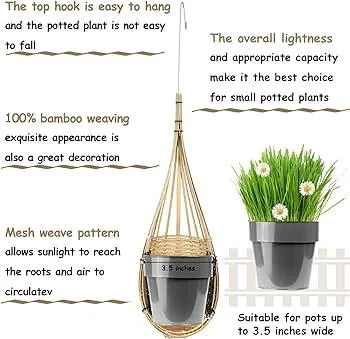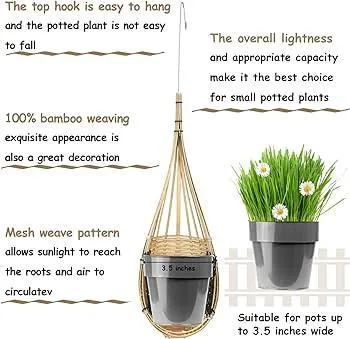The Ultimate Guide to Choosing the Best Hanging Plants for Your Home
If you’re looking to add some green living decor to your indoor spaces but don’t have much floor space, hanging plants are the perfect solution. They not only make great accent pieces but also help to purify the air. In this article, I’ll discuss the top plant options for hanging baskets and how to care for them. By the end, you’ll have all the info you need to pick out the best hanging plants for your home.
Trailing Ivy Plants
Probably one of the most common and low-maintenance hanging plants is ivy. There are several varieties that work well for indoors, such as English ivy (Hedera helix), Swedish ivy (Plectranthus verticillatus), and Japanese ivy (Hedera rhombea). Ivy plants have beautiful foliage and a natural trailing form that lends itself to hanging baskets. They do well in medium to low light conditions and require watering once the top inch of soil is dry.
English ivy makes an excellent choice if you have limited space. This classic variety grows quickly and can trail several feet. I’ve had good luck with English ivy—even when I’ve forgotten to water it for weeks! Just give it some sun or bright indirect light and it will thrive. You can prune it into shape and enjoy the dark green heart-shaped leaves.
Spider Plants
Spider plants (Chlorophytum comosum) are one of the most ubiquitous and forgiving houseplants around. They do well in a variety of lighting conditions from low to bright light. The long grass-like leaves emerge from the base forming an attractive fountain shape. Spider plants are known for producing small plantlets called “spiderettes” along the stems that can be easily rooted to create new plants.
Water spider plants when the topsoil is dry and fertilize monthly during the growing season for vigorous growth. Propagation is as easy as plucking off a spiderette, placing the bottom few inches in water until roots develop, then potting it up. Spider plants have been a staple of homes and offices for decades due to their hardiness and ease of care. If you want a nearly foolproof hanging plant, this one’s a sure bet.
Philodendron
Within the large philodendron genus, some wonderful varieties work well for indoor hanging baskets like heartleaf philodendron (Philodendron hederaceum) and brasil philodendron (Philodendron erubescens). They have beautiful large deep green foliage that retains its color well indoors. Philodendrons thrive in medium to low light and appreciate high humidity. Water when the top inch of soil is dry and mist the leaves occasionally.

From my experience, philodendrons are very forgiving plants. I’ve seen them prosper even when they’re not watered or misted on a consistent schedule. Their lush leaves add drama to any room. Try training a brasil or heartleaf philodendron up a moss pole for a stunning hanging accent piece that keeps growing year after year with simple care.
Pothos
Pothos or devil’s ivy (Epipremnum aureum) is hard to beat for low maintenance indoor hanging baskets. Its trailing stems can grow to lengths of 10 feet or more if given space to climb. Pothos are extremely tolerant of low light and can even survive in dark bathrooms if watered regularly. Their bold variegated or solid green leaves are perfect for brightening up dull corners.
Pothos are kind of like the cockroaches of houseplants—you can totally abuse them and they’ll still kick along. I’ve seen these guys bounce back even after nearly drying out completely. Water them when the soil is dry and enjoy! Pothos make wonderful pets for beginners and require basically no care. Their near-indestructible nature is part of their appeal as a hanging basket plant.
Peperomia
If you prefer more unusual foliage, consider peperomias. This diverse genus includes many dwarf varieties well-suited to hanging planters like radiator plant (Peperomia caperata) and ripple peperomia (Peperomia obtusifolia). Their finely textured round or heart-shaped leaves come in shades of green, white, and red-tinged colors.
Peperomias love medium to bright light. The trick to caring for them is allowing the soil to dry slightly between waterings since they’re susceptible to root rot if overwatered. These make low-effort statement plants you don’t see everywhere. And who could resist that adorable little radiator plant?
Senecio
Last but not least are senecios or string-of-beads plants, which create stunning modern hanging displays. Varieties like string-of-pearls (Senecio rowleyanus) and string-of-bananas (Senecio radicans) have tight ropes of geometric foliage on extremely fine stems. They thrive in medium to bright light and can trail up to 3 feet long.

These guys are fairly intense and need drier conditions between waterings. But when potted up in airy mixes and allowed to dry out partly, they’ll reward you with their unique sculptural forms dangling overhead. Use senecios to add visual interest against a large blank wall. With some TLC these babies can keep cascading for years!
Caring for Hanging Baskets
Now that you’ve selected some specimens, here are some basics on caring for hanging plants:
- Potting: Use lightweight pots with drainage holes and a soil-less or well-draining mix for air circulation around roots. Terra cotta and plastic work well.
- Watering: Water thoroughly when the top inch of soil is dry, then drain any excess water from the saucer below. Avoid getting foliage wet.
- Light: Position hanging baskets in a spot receiving medium to bright indirect light for 4-6 hours daily. Adjust as needed for plant requirements.
- Fertilizing: Feed monthly in spring and summer with a diluted liquid houseplant fertilizer.
- Pruning: Remove any dead, diseased or damaged growth as needed to keep plants looking tidy.
- Repotting: Repot yearly or when roots fill the container into the next pot size up using fresh potting mix.
With regular care and reminders to water, your hanging plants should thrive indoors all year round. Periodically rotate the baskets for even light exposure too. Following these tips will help keep them healthy and turning heads for seasons to come.
Frequently Asked Questions
Here are answers to some additional questions people commonly have about caring for hanging plants:
Do hanging plants need fertilizer?
Most plants will benefit from a regular feeding during the active growing season using a diluted liquid houseplant fertilizer every 4-6 weeks. However, low-maintenance varieties like ivy and pothos survive without much fertilizer. It’s best to treat symptoms—only feed if growth looks sluggish.
How often should hanging baskets be watered?
Watering frequency depends on factors like pot size, plant type and climate conditions. As a general rule, check the soil moisture every 5-7 days by sticking your finger an inch deep. Water thoroughly when the top inch is dry. During hot/dry weather, check more often like every 2-3 days.

What’s the best way to transport a hanging basket?
I usually remove hanging baskets from their hooks and place the entire nursery pot inside a large sealed plastic bag. This helps protect the foliage and soil from spills or breakage when transported. You can also lay the potted plant on its side inside the bag if it’s top-heavy. The key is keeping everything contained.
How do I revive a dying hanging plant?
First, check the growing conditions and make sure any issues with light, water
“Best Plants for Hanging Indoor”
| Plant | Light Needs | Watering | Care Level |
|---|---|---|---|
| Pothos | Low | Let soil dry out between waterings | Low |
| Philodendron | Medium | Water when top inch of soil is dry | Low |
| Spider Plant | Medium | Let soil dry out slightly between waterings | Low |
| English Ivy | Low | Water when top inch of soil is dry | Low |
| Peperomia | Medium | Let soil dry out slightly between waterings | Low |
FAQ
-
What are some good hanging plants for indoor areas with low light?
Pothos and philodendron plants do really well hanging in spots with not very much sunlight. They don’t need very much light to continue growing. Spider plants also can tolerate low light conditions pretty good.
-
Are hanging vines a good choice for small spaces?
Yes, hanging vines are an awesome option for little areas that don’t have much room. They grow vertically so you can use vertical space instead of taking up floor space. Vines like pothos or english ivy or swiss cheese plant fill out nicely while taking up very little floor room. They basically maximize the space you have available.
-
What types of hanging plants need the most water?
Flowers and tropicals tend to need more water than others. Plants from tropical rainforests like spider plants, peace lilies, and philodendron will dry out faster than plants from less rainy environments. It’s important to check the soil of tropical hanging plants more often, perhaps every five days or so, to make sure it doesn’t get too dry. Always water when the top inch or so of soil is dry.
-
Do hanging baskets need fertilizer?
Kinda – while hanging basket plants can survive without fertilizer, applying a dilute water-soluble fertilizer during the spring and summer growing months will help them stay bushy and flowers/foliage stay healthy looking. Fertilize once every few weeks at 1/2 or 1/4 strength of what the label says. Too much fertilizer could damage roots. Maybe hold off in winter when growth slows down some.

-
How do you encourage vines to grow longer?
To get vines to lengthen out, give them something to climb. Attach their pots to hooks dangling from the ceiling or use stakes or poles for them to climb up. Putting them in bright, indirect light also seems to inspire them to reach higher. Trimming them back occasionally may stimulate new growth too. With the right conditions, vines will climb and climb, filling out the whole space in no time.
-
Which popular houseplants are not good choices for hanging baskets?
Plants like bamboo palm, dracaena, or snake plant don’t vine or climb and don’t seem to enjoy being hung upside down too much. Their leaves may face downward awkwardly. Peace lilies, though gorgeous, are a little weighty when wet and could possibly spill over edges of pots with big rains. Succulents also do not take well to constant wet feet. But most tropical or vining favorites do outstanding in hanging planters with good drainage.
